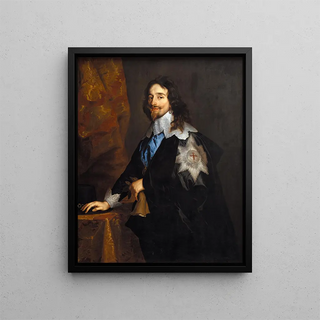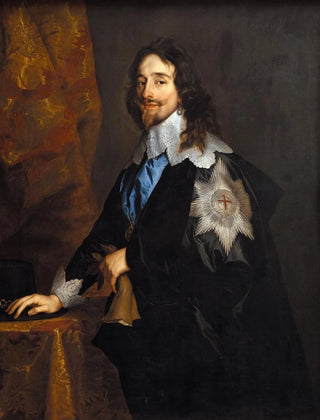Art print | King Charles I of England - Anthony van Dyck


View from behind

Frame (optional)
Reproduction of King Charles I of England - Antoine van Dyck – Captivating Introduction
The painting "King Charles I of England" by Antoine van Dyck is much more than a simple portrait; it is an iconic work that embodies the majesty and complexity of a monarch amid the tumult of his era. Created in the 17th century, this piece marks a pivotal moment in English history. The king, frozen in a posture that is both noble and vulnerable, appears to engage in dialogue with the viewer, inviting reflection on power, responsibility, and destiny. The art print of this masterpiece allows appreciation not only of the artist's technical virtuosity but also of the psychological depth conveyed through this representation.
Style and uniqueness of the work
Van Dyck's style is distinguished by his ability to capture not only the physical appearance of his subjects but also their essence. In "King Charles I of England," the warm color palette and the interplay of shadow and light create an atmosphere that is both intimate and solemn. The king is depicted with great dignity, dressed in a sumptuous outfit that highlights his royal status. The meticulous details, from the embroidery of his attire to the reflections in his crown, demonstrate a keen sense of observation and exceptional technical mastery. The background, though understated, helps to emphasize the central figure, accentuating the monumental character of the scene. This portrait is a true ode to monarchy, but also a reflection of the political tensions that traversed England at that time.
The artist and his influence
Antoine van Dyck, a pupil of Rubens, established himself as one of the most influential portraitists of his era. His time in England, where he became a court painter, marked a turning point in his career. He developed a style that combines Flemish baroque with British sensibility, thereby redefining royal portraiture. Van Dyck inspired many artists who followed him, leaving an indelible mark on art history. His approach to portraiture, focused on personality and charisma of the subject, paved the way for generations of artists,

Matte finish

View from behind

Frame (optional)
Reproduction of King Charles I of England - Antoine van Dyck – Captivating Introduction
The painting "King Charles I of England" by Antoine van Dyck is much more than a simple portrait; it is an iconic work that embodies the majesty and complexity of a monarch amid the tumult of his era. Created in the 17th century, this piece marks a pivotal moment in English history. The king, frozen in a posture that is both noble and vulnerable, appears to engage in dialogue with the viewer, inviting reflection on power, responsibility, and destiny. The art print of this masterpiece allows appreciation not only of the artist's technical virtuosity but also of the psychological depth conveyed through this representation.
Style and uniqueness of the work
Van Dyck's style is distinguished by his ability to capture not only the physical appearance of his subjects but also their essence. In "King Charles I of England," the warm color palette and the interplay of shadow and light create an atmosphere that is both intimate and solemn. The king is depicted with great dignity, dressed in a sumptuous outfit that highlights his royal status. The meticulous details, from the embroidery of his attire to the reflections in his crown, demonstrate a keen sense of observation and exceptional technical mastery. The background, though understated, helps to emphasize the central figure, accentuating the monumental character of the scene. This portrait is a true ode to monarchy, but also a reflection of the political tensions that traversed England at that time.
The artist and his influence
Antoine van Dyck, a pupil of Rubens, established himself as one of the most influential portraitists of his era. His time in England, where he became a court painter, marked a turning point in his career. He developed a style that combines Flemish baroque with British sensibility, thereby redefining royal portraiture. Van Dyck inspired many artists who followed him, leaving an indelible mark on art history. His approach to portraiture, focused on personality and charisma of the subject, paved the way for generations of artists,






